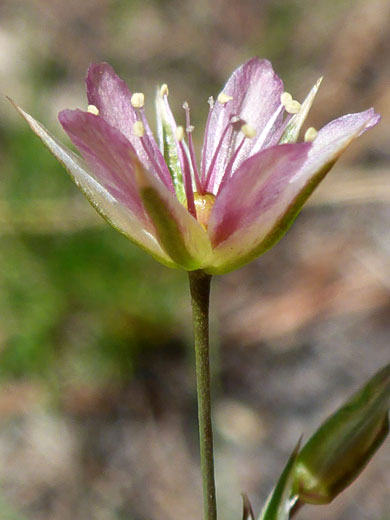Eremogone Eastwoodiae, Eastwood's Sandwort
Plants > Wildflowers > Caryophyllaceae > Eremogone Eastwoodiae
Common name:
Eastwood's sandwort
Family:
Scientific name:
Eremogone eastwoodiae
Synonym:
Arenaria eastwoodiae
Main flower color:
Range:
The Four Corners states, and Wyoming
Height:
Up to 10 inches
Habitat:
Semi-deserts, dry hillsides, rocky places, from 4,000 to 7,200 feet
Leaves:
Narrow, linear, basal and cauline, up to 1.2 inches long
Season:
May to August
Eremogone eastwoodiae is a relatively common plant of the Colorado Plateau, its range extending northwards into southern Wyoming. Leaves are usually hairless but may have a sparse covering of very short hairs; they grow at the base and in two to four pairs along the stem. Stems (and pedicels) may have a sparse covering of glandular hairs (var adenophora) but otherwise are glabrous (the more widespread var eastwoodiae). Leaves terminate in a sharp point.
The inflorescence is an open cluster, of up to 15 heads. The five lanceolate, narrow-tipped sepals are green or purplish, edged with a broad, thin, light-colored margin, while the five petals are white, pale yellow or pinkish, oblanceolate in shape, and usually slightly longer than the sepals. At the center are ten purple stamens, above each of the petals and sepals, and three thin styles. Each sepal has a yellow, bi-lobed nectary at its base.
The inflorescence is an open cluster, of up to 15 heads. The five lanceolate, narrow-tipped sepals are green or purplish, edged with a broad, thin, light-colored margin, while the five petals are white, pale yellow or pinkish, oblanceolate in shape, and usually slightly longer than the sepals. At the center are ten purple stamens, above each of the petals and sepals, and three thin styles. Each sepal has a yellow, bi-lobed nectary at its base.
All Contents © Copyright The American Southwest | Comments and Questions | Contribute | Site Map






